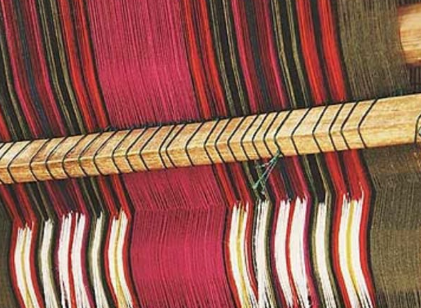Weaving, one of the most ancient crafts of Nepal finds mention in many ancient texts; there are also are numerous other references in old books and manuscripts to barter trade with woven products and to spinning and weaving wool and cotton for domestic purposes. Cotton cloth was also used as a base for thangka paintings: religious illustrations and pata (banners), some dating back to about AD 900. The goddess Saraswati who is believed to preside over all kinds of handicrafts is still given offerings of cotton on Shripanchami – the day each year that the goddess arrives in Nepal.
TRADITIONS
Till a few decades ago, across Nepal, the sound of weaving could be heard in most Newari homes. The women spun and wove in their leisure hours. They not only produced cotton cloth for their own use, but also sold their output in the market. It was also customary for those belonging to a weaver’s community to present a spinning wheel to the daughter as a wedding gift, thereby propagating and preserving the traditional skill. This practice has now become obsolete. Cotton is no longer grown on as large a scale in Nepal as it was earlier and most of the raw cotton is imported from the neighbouring countries.
PROCESS & TECHNIQUE
Cotton collected from plants is separated from its seed using a traditional ginning machine known as keku. This cotton is beaten into a fluffy mass using a traditional bow fitted with string (mayeka). For spinning, the cotton is twirled into 6″ long strands called pyuri. Cotton is spread on a flat surface and rolled up around a stick. These pyuris are used in spinning yarn on a wooden spinning wheel. The yarn is slowly drawn out of the cotton roll attached to the poised iron rod of the rotating wheel. The yarn is wound on to bamboo pieces called thuris.

To make the yarn less adhesive, coils of yarn thus obtained are treated with rice gruel, made from rice waste and oil. The yarn is then rolled on to a wooden device by the name of phelu. The stretching of the yarn is done by fixing pairs of bamboo sticks in an upright position on the open ground at a distance of about one yard from each other. The distance to which the yarn is stretched depends on the kind and size of the cloth. Women hold the phelu in the left hand and stretch the yarn with the right hand across the sticks as they move forward. They count the number of turns of yarn required for the cloth. Threads of different colours are stretched and finally they are rolled up in bundles. The stretched threads serve as the warp in the loom.
The yarn is also fed into the thuri made of the horn of the buffalo. The thuri is a flying shuttle and the yarn wound in this serves as the weft yarn. This has now been replaced by imported iron frames.
The traditional looms of Nepal have a wooden framework and are primitive in nature. The warp is stretched between the front and back wooden rolls provided with two wooden pedals. These pedals are tied with thick and strong thread called mayeka. The weaver presses the pedal alternately with the leg and makes a free passage for the shuttle to move across. The thread moves up and down, in turn pressing the pedals. The yarn of the flying shuttle is interwoven with the warp thread in this operation. The hand bar called hata is drawn towards the weaver each time the shuttle moves across the warp. This leads to a compact weave. The woven cloth is wound around the front wooden roll. More warp thread is fed into the loom by unfolding the roll at the back of the loom.
Various types of cotton textiles are woven on the traditional looms. Among these, the notable ones are patasi (black sari), kora, khaddar, khandi, gharbuna, woollen chaddar, and kogati etc.
- Kora is a rough and thin cotton cloth used as a quilt cover. It has a plain white weave. The material is quite tough and durable, and after one wash it becomes soft and somewhat thicker.
- Khandi is also a plain white cotton cloth woven in a compact form. It is used chiefly for making garments, especially for men.
- Khaddar is used for various purposes and serves as a garment for both men and women. It comes in various colours and intricate designs. It is also used for making bed covers, bed sheets and curtains.
- Fine cotton cloth dyed with kogati (saffron) colour is used in making the Nepali national dress for men and women.
LOCATION
Handloom fabric weaving was a traditional craft prevalent in Bhaktapur, Lalitpur, Kirtipur and the Kathmandu Valley.
Gallery
YOUR VIEWS
PRACTITIONERS: INDIA
Access 70,000+ practitioners in 2500+ crafts across India.
BIBLIOGRAPHY
10,000+ listings on arts, crafts, design, heritage, culture etc.
GLOSSARY
Rich and often unfamiliar vocabulary of crafts and textiles.
SHOP at India InCH
Needs to be written.





